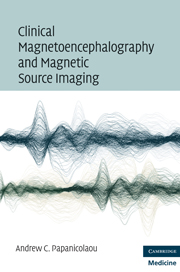Book contents
- Frontmatter
- Contents
- Contributors
- Preface
- Section 1 The method
- 1 Basic concepts
- 2 The nature and origin of magnetic signals
- 3 Recording the magnetic flux
- 4 Overview of MSI using the single equivalent current dipole (ECD) model as an example
- 5 The fundamental problems of MSI
- 6 Head models
- 7 Source models – discrete source models
- 8 Source models – distributed source models
- 9 Source models – beamformers
- 10 Pragmatic features of the clinical use of MEG/MSI
- Section 2 Spontaneous brain activity
- Section 3 Evoked magnetic fields
- Postscript: Future applications of clinical MEG
- References
- Index
3 - Recording the magnetic flux
from Section 1 - The method
Published online by Cambridge University Press: 01 March 2010
- Frontmatter
- Contents
- Contributors
- Preface
- Section 1 The method
- 1 Basic concepts
- 2 The nature and origin of magnetic signals
- 3 Recording the magnetic flux
- 4 Overview of MSI using the single equivalent current dipole (ECD) model as an example
- 5 The fundamental problems of MSI
- 6 Head models
- 7 Source models – discrete source models
- 8 Source models – distributed source models
- 9 Source models – beamformers
- 10 Pragmatic features of the clinical use of MEG/MSI
- Section 2 Spontaneous brain activity
- Section 3 Evoked magnetic fields
- Postscript: Future applications of clinical MEG
- References
- Index
Summary
The shape of the recorded flux distribution on the head surface is jointly determined by the characteristics of the flux that emerges from the intracranial sources and the characteristics of the recording instruments. Magnetic flux lines emanating from a source emerge on the head surface as concentric spheres. At the head surface, these flux lines can be detected by special sensors called magnetometers or gradiometers. A magnetometer is a loop of wire which can be placed parallel to the head surface, as shown in Fig. 3.1.
As the flux lines thread through the loop, they create a current by induction in the loop. The strength of the current is proportional to the density of the flux at that point; so that by knowing the value of the induced current, we have a measure of the flux strength at that point. If a sufficient number of magnetometers are placed at regular intervals over the entire head surface, the shape of the entire distribution created by a brain activity source can be determined (see Fig. 3.2).
No matter how great in intensity the intracranial source might be, no matter how great the deviation from baseline activity, the magnetic fields created are extremely small. Typically, the magnetic fields associated with evoked brain activity do not exceed a few hundred femtotesla (fT, or 10−15 tesla) in amplitude.
- Type
- Chapter
- Information
- Publisher: Cambridge University PressPrint publication year: 2009



